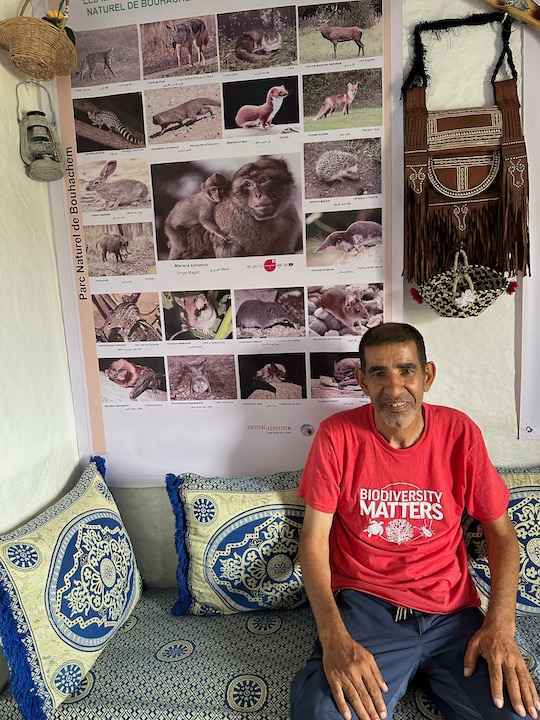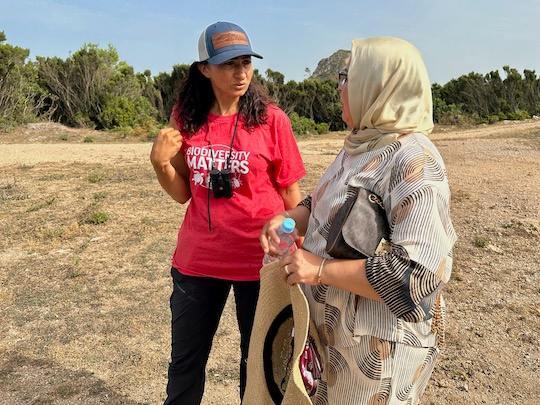
Seeing Conservation Up Close
Donors visit CEPF grantees in Morocco
25 September 2023
Editor's Note: Not long after the field visit described in the following article, Mediterranean Basin countries Morocco and Libya were subject to tragic disasters—western Morocco was struck by a magnitude 6.8 earthquake on 8 September and many aftershocks, while Libya suffered devastating flooding and landslides associated with a storm. Thousands of people lost their lives and many more were injured and lost their homes and livelihoods. CEPF grieves for the loss of life and extends its deepest condolences to the people of Morocco and Libya and their friends and loved ones.
In Morocco, CEPF has been in touch with our grantees in the extended Marrakech region, as well as Tahanout and Toubkhal, and we have been relieved to find there was no loss of life among our grantees and partners in the region, although a few suffered minor injuries and destruction is widespread.
In Libya, the staff members of our partner based in Derna, the organization Hayat Organization to Protect Wildlife and Marine Organism, were found to have escaped loss of life and injury; and our partners from Western Libya experienced no casualties directly. However, many have lost members of their families and friends.
----
The extreme heat did not deter representatives of CEPF's Donor Council who visited three conservation projects in Morocco on the heels of a Donor Council meeting held in Tangier and virtually in mid-July.
Morocco was chosen as the site for the meeting because it is one of 13 countries included in CEPF's ongoing investment in the Mediterranean Basin Biodiversity Hotspot. CEPF has been funding conservation for more than 10 years in the hotspot, investing US$23 million in 278 projects.
Those joining the field visit included Donor Council Chairperson Julia Marton-Lefèvre; Global Environment Facility CEO and Chairperson Carlos Manuel Rodriguez; Conservation International Executive Vice President for Conservation Partnerships Sebastian Troëng; European Commission Team Leader for Biodiversity and Ecosystem Services Thierry Dudermel; and CEPF Executive Director Olivier Langrand. Also joining the trip were Pierre Carret, CEPF Mediterranean Basin grant director, and Awatef Abiadh, North Africa program officer for CEPF's Mediterranean Basin Regional Implementation Team, also participated.
"The GEF is very proud to be here supporting CEPF not just because of the wonderful work that is being done in the biodiversity hotspot, but most important, they are working with the grassroots civil society organizations on the ground that give the sustainability element that the GEF looks for in its investments," said Carlos Manuel Rodriguez.
Protecting globally threatened plant species

The field visit started with a drive to Chefchaouen, where the group met with a delegation from the provincial forest department and administrators from Talassemtane National Park. Next, they drove to the park to the site of a project led by the Moroccan organization Association Nature Solutions. Imad Cherkaoui, president of Association Nature Solutions, explained that the project team has worked with the park administration to integrate plant conservation into the site's management. CEPF's grant supported Association Nature Solutions to assess the status of plants in the park and work with park authorities and inhabitants to improve practices such as agriculture and grazing to protect the most endangered plants. The project, which was completed in August 2021, resulted in:
The training of botany students, forest engineers and association staff in project set-up and management and in the open standards method for nature conservation.
A catalog of and conservation action plan for Endangered and Critically Endangered plants and other rare and endemic taxa.
A communication strategy and the website to interest young people in plant conservation.
Traditional practices benefit people and endemic primate species

Next the group met with Ahmed El Harrad, president of grantee Barbary Macaque Conservation in the Rif Mountains to learn about its efforts to help Bouhachem Nature Park recover from a 2022 wildfire, encourage agro-ecological practices and increase revenues from biodiversity-friendly practices in the area.
The project, which began in 2019 and will be completed this fall, seeks to reduce threats to the Endangered primate species the Barbary macaque (Macaca sylvanus) and its montane forest habitat. The organization has supported participatory management of natural areas with local communities and integrating eco-friendly traditional practices.
Results to date include rescuing and monitoring of macaques affected by the summer 2022 fire; setting up a fire warning system by working with representatives of villages and associations, the regional water and forestry officials; and supporting the establishment of two farmers' cooperatives and the promotion of Bouhachem and its agricultural products via ecotourism.

The fire was particularly hard on the macaques of Bouhachem, which hosts Morocco's second largest population of the species. An estimated 500 to 1,000 were killed in the fire—between 12.5% and 25% of Bouhachem's total population. The spring of 2023 was marked by a low number of newborns due to the stress caused by the fires on the macaques, making the long-term intervention of Barbary Macaque Conservation a crucial element for the survival of this species.
“The Barbary macaque is the only primate found north of the Sahara and the only macaque found outside of Asia," said CEPF Executive Director Olivier Langrand. "It is critically important to conserve this species, which is threatened by illegal trade and poorly managed tourism, and whose distribution is now limited to the altitude forests of Morocco and Algeria as a result of pastoralism.”
Balancing the needs of livestock and vultures
After Bouhachem, the field visit continued on to the Jbel Moussa protected area. Rising from sea level to 841 meters, the karstic limestone massif makes up one of the two "Pillars of Hercules," situated opposite the Rock of Gibraltar on the African side of the Strait of Gibraltar.

Here, Rhimou El Hammoumi, president of Groupe de Recherche pour la Protection des Oiseaux au Maroc (GREPOM), shared the results of GREPOM's CEPF-funded that helped local sheep farmers improve their livelihoods while adopting practices favorable to biodiversity—particularly vultures, which are crucial to healthy ecosystems and under tremendous threat in the region and globally.
For the project, which was completed in December 2022, the GREPOM team initiated a participatory process to establish a sustainable grazing management plan and support farmers by improving water sources, setting up rendering platforms and improving access to markets through a certification program. The project led to the foundation of a pastoral cooperative and the training of members in management and pasture improvement. The project also laid the groundwork for the development of future ecotourism activity based on birdwatching in the area.
Another of the project's key achievements was the tagging of vultures with GPS transmitters. In addition to the knowledge acquired about the dispersal movements of the Critically Endangered Rüppell's vultures (Gyps ruppellii)—the world's highest-flying bird—in Morocco and beyond, GPS tracking has important implications for the conservation of this species and other vultures and large birds of prey in general. For example, GPS tracking has made it possible to detect threats that are little known in Morocco (such as electrocution) or known only in other countries (for example, collision with wind turbine blades).

Project activities also included providing food and water sources in times of shortage for Griffon vultures (Gyps fulvus) and other birds of prey in the area. And an awareness-raising program has reached more than 200 schoolchildren, informing students about pastoralism and birds, focusing on the characteristics of griffon vultures and their ecological role.
Contributing to a hotspot-wide conservation strategy
The projects included in the field visit are important pieces of a broad conservation strategy for the Mediterranean Basin Biodiversity Hotspot and are excellent examples of the results being generated by civil society—nongovernmental organizations, Indigenous peoples and local communities, universities and the private sector—toward the goal of protecting the biodiversity of this amazing region.
"CEPF grantees are contributing not only to implementing CEPF's strategy for the region, but also to the achievement of global goals for biodiversity conservation such as those found in the Convention on Biological Diversity's Kunming-Montreal Global Biodiversity Framework," said CEPF Grant Director Pierre Carret. "The combined efforts of our grantees in the Mediterranean Basin are making a difference for nature and people."